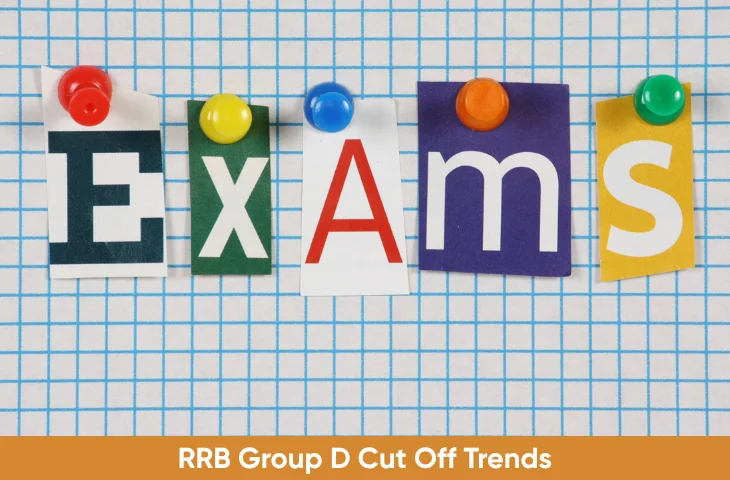Understanding historical patterns helps aspirants form realistic targets. This article examines RRB Group D Cut-Off Trends from 2018–2022, teases out the drivers behind ups and downs, and gives evidence-based expectations for 2025 — so you can plan preparation and target scores strategically.
RRB Group D Cut Off Trends At a Glance (2018–2022)
The points below provide major information for RRB Group D Cut Off Trends (2018 – 2022):
- Vacancy spikes and troughs between 2018–2022 affected competition patterns: 2019 saw a very large recruitment drive, while other years had far fewer posts. The year-wise vacancy distribution (2018–2021) shows substantial variation that influenced cut-offs.
- Cut-offs for 2022 show significant regional variation (zone-wise) and category differences – normalized marks for UR candidates in many zones were in the mid-60s (out of 100) in 2022, with “open” raw marks much higher due to multi-shift normalization.
Why Study Past Cut-Off Trends?
Studying and considering the past cut off trends helps candidates predict the current year’s qualifying marks.
- Cut-offs reflect the interaction of vacancies × applicants × difficulty.
- Historical trends reveal which factor tended to dominate in different years and regions, and therefore indicate how future changes (large new vacancy notifications, exam difficulty) could move cut-offs.
Timeline of Vacancies and Notable Cut-Off Observations (2018–2022)
We have given below the timeline for vacancies and notable cut off observations from 2018 – 2022:
| Year | Approximate Total Vacancies | Notes |
| 2018 | ~62,000 (major recruitment rounds around 2018–19) | Large-scale hiring after long gap. |
| 2019 | ~55,000+ (RRC/Group C/Level-1 waves included) | One of the largest single-year drives; lowered pressure in some zones. |
| 2020 | Small numbers (pandemic + smaller drives) | Hiring slowed globally. |
| 2021 | Few thousand (ad hoc, zone-wise) | Smaller drives; local competition higher. |
| 2022 | Multiple zone cut-offs published — normalized UR cut-offs often ~62–70 range | Zone variation pronounced; normalization applied. |
What Drove Cut-Off Movement Between 2018–2022?
Various factors drove off the cut off between 2018 – 2022. Some of them are given below:
1. Vacancy volume (supply)
- Large vacancy years (2018–2019) can ease cut-offs if applicant numbers don’t surge proportionally. But the impact is moderated by other factors (applicant turnout, multi-shift difficulty).
2. Number of applicants and attendance
- Even with many vacancies, higher applicant turnout (driven by publicity, relaxed eligibility, or economic conditions) can keep cut-offs steady or even push them up.
3. Paper difficulty and normalization
- Multi-shift exams use normalization — a tougher shift can lower raw scores but normalized cut-offs adjust; hence published cut-offs often show less dramatic year-on-year swings than raw difficulty would suggest. Zone-wise normalized UR marks in 2022 commonly sat in mid-60s for many zones.
4. Category and regional dynamics
- Reserve category rules and differential performance across zones create different cut-off floors – UR cut-offs will not behave identically across regions. 2022 examples show this vividly.
RRB Group D Cut Off Trends Zone – Wise
The RRB Group D Cut Off Trends zone wise is given below for reference:
| Zone | UR Normalized Cut Off | Notes |
| Allahabad | ~66 (normalized) | Higher raw “open” scores but normalized ~66. |
| Bhubaneswar | ~66.5 (normalized) | Zone-wise performance strong. |
| Kolkata | ~69.6 (normalized) | One of the higher normalized cut-offs in 2022. |
What to Expect in 2025?
After observing the RRB Group D Cut Off Trends 2025, candidates can expect the following:
Known/Observable signals for 2025:
- RRB announced a major Group D cycle for 2025 with a national notification covering ~32,438 vacancies (exam schedule announced for Nov–Dec 2025). Large centralized drives like this can alter competition patterns.
- If applicant turnout is high (post-pandemic economic conditions, backlog of aspirants), cut-offs may not drop proportionally to vacancies.
Scenario-Based Expectations:
- Optimistic scenario (low turnout / hard paper): Normalized UR cut-offs could fall 2–6 marks below the 2022 zone medians.
- Neutral scenario (similar turnout / similar difficulty): Cut-offs around 2022 levels (mid-60s normalized for many zones).
- Competitive scenario (high turnout / easy paper): Cut-offs could match or exceed 2022 normalized marks — aspirants must aim higher.
RRB Group D Exam Action Plan for Aspirants
Every exam aspirant must develop proper preparation strategies and action plan to qualify in the first attempt. Check out the details below:
| Category | Key Points |
| Score Targets | Minimum safe target: Historical normalized UR median + 5 marks buffer.• For many zones, mid-60s + buffer → Target ≈ 70+ normalized marks. |
| Preparation Priorities | Master high-weight topics: Mathematics, Reasoning, and General Science.• Build speed with timed mocks — normalization ensures fairness, but speed + accuracy determines raw ranking.• Focus on zone-specific past papers, as zone behavior influences cut-offs. |
| Exam-Day Tactics | Maximize accuracy in the first 40–50 minutes to build a margin for safe attempts or guesses later.• Use sectional time checks — avoid getting stuck on high-time-consuming questions. |
Summary
Check out the key points of RRB Group D Cut Off Trends:
| Question | Short Answer |
| Does more vacancy automatically mean lower cut-off? | No – vacancy helps but other factors (turnout, paper difficulty, normalization, regional demand) can override it. |
| 2018–2022 trend in brief | Large vacancy years (2018–19) vs low years; 2022 showed mid-60s normalized UR cut-offs in many zones. |
| 2025 expectation | With a large 2025 drive (~32,438 posts) outcome depends on turnout and difficulty — aim for a comfortable buffer above 2022 medians. |
| Practical target | Historical normalized UR median + 5–8 marks (zone dependent). |
| Key prep focus | Speed + accuracy, mock tests, zone-wise analysis, target buffering. |
The RRB Group D Cut-Off Trends from 2018–2022 show that cut-offs are the product of several moving parts: vacancies, applicants, exam difficulty, normalisation, and regional demand. While a large vacancy notification for 2025 (≈32,438) is welcome news for aspirants, it does not guarantee substantially lower cut-offs — turnout and exam difficulty will shape the final picture. Your best strategy: prepare to exceed historical normalised medians for your chosen zone, prioritise speed and accuracy, and keep a buffer of marks to ride out year-to-year volatility.
FAQs
RRB Group D cut-off trends are analyzed by comparing normalized scores across regions, categories, and exam years. Factors like exam difficulty, number of candidates, and total vacancies help identify whether the cut-off is rising, stable, or declining over time.
The variation occurred mainly due to differences in exam difficulty levels, normalization effects, number of shifts, and a significant change in vacancy distribution among RRB zones. The 2022 exam also saw tighter competition due to higher participation rates.
Based on the RRB Group D Cut-Off Trends from 2018–2022, experts expect the normalized cut-off for the General category to range between 72–80 marks, depending on the region and exam difficulty.
Not necessarily. While higher vacancies can ease competition slightly, other factors—like exam difficulty, normalization, and performance of top candidates—play a much larger role in determining the final cut-off marks.
Aspirants can analyze previous years’ trends to set a realistic target score. For instance, aiming for 10–12 marks above the previous cut-off provides a safe buffer and increases selection chances across regions.
- RRB Group D City Intimation Slip 2025, View City Slip and Shift Timings
- RRB Group D Vacancy Trend Analysis, Check Details
- रेलवे परीक्षा की तैयारी करें, सारी जानकारी यहां देखें
- RRB Group D Study Plan for 15 Days, Check Daily Schedule
- Important RRB Group D Exam Day Guidelines, Check Now
- Important Biology Chapters for RRB Group D Exam, Know Details

Hello! This is Arijit Dutta. I am a skilled Content Writer at Oliveboard with nearly 3+ years of experience in crafting engaging, informative, and exam-focused content for the Railways Domain. With a strong command of language and a keen understanding of learner needs, I contribute significantly to Oliveboard’s mission of delivering high-quality educational resources. Passionate about clear communication and continuous learning, I consistently create content that helps government job aspirants achieve their goals. Outside of work, I enjoy playing cricket and listening to music, which helps me stay balanced and creative in my professional journey.
